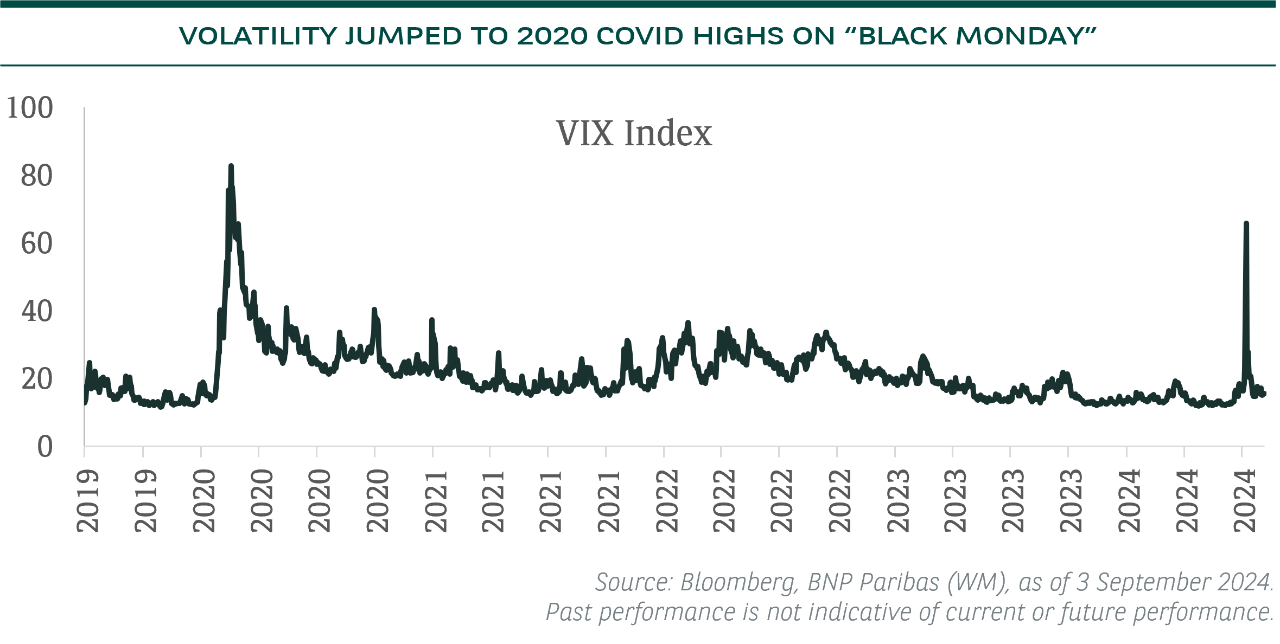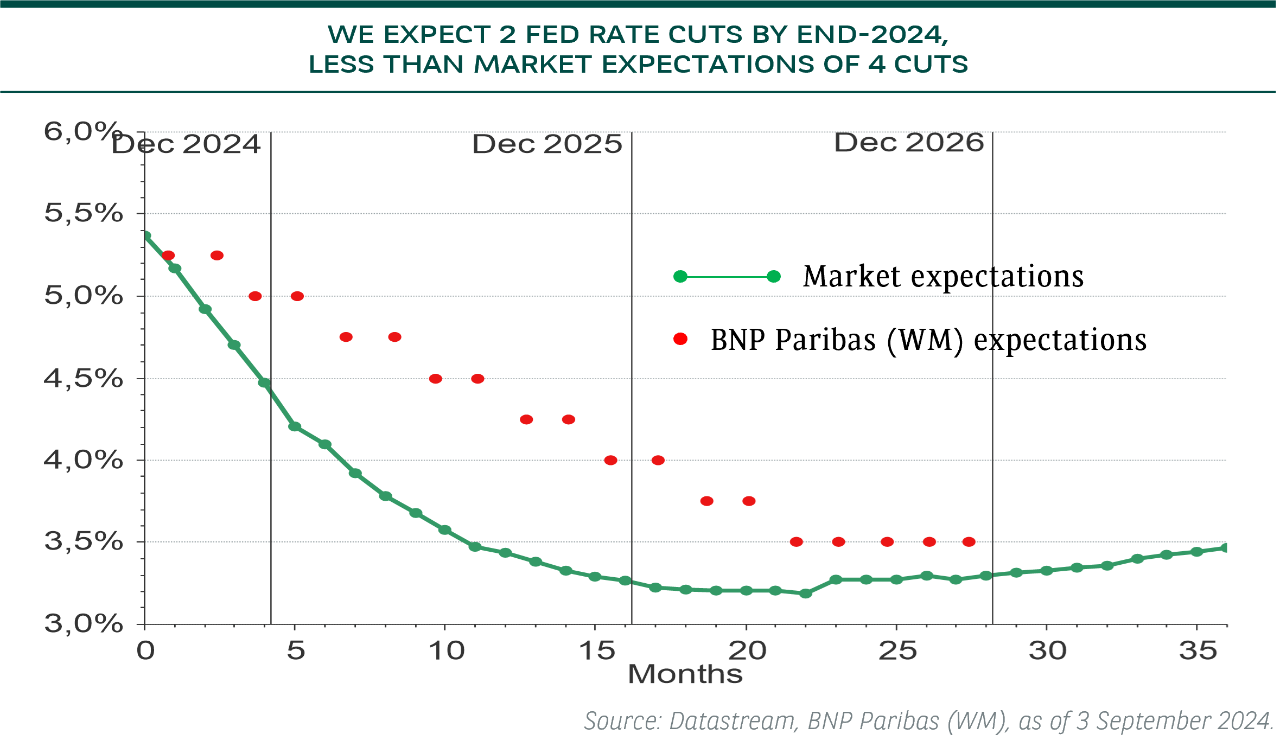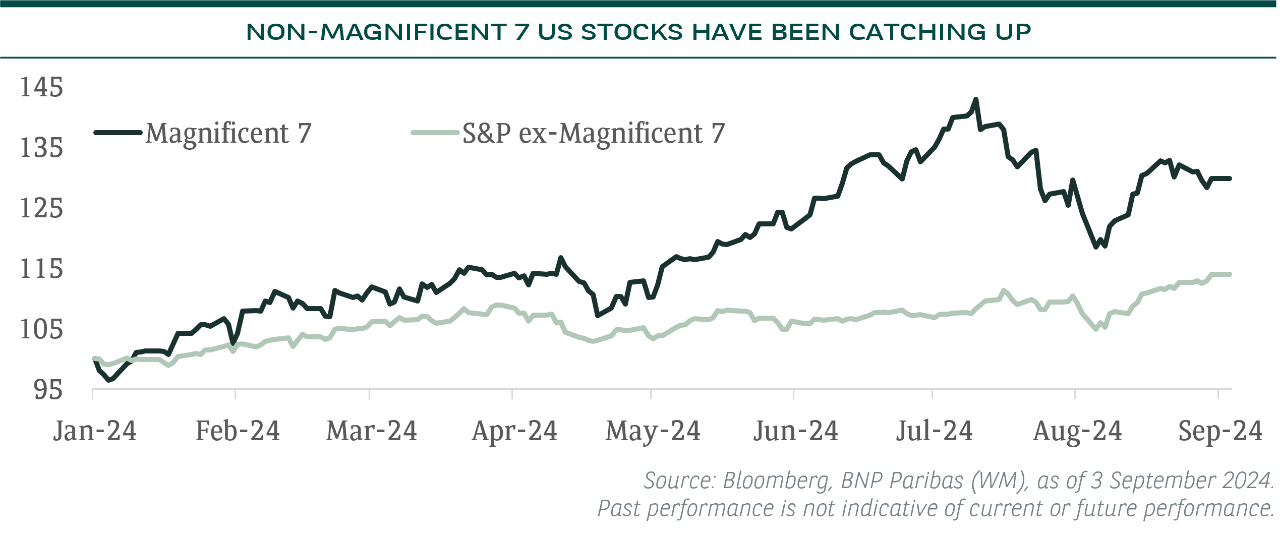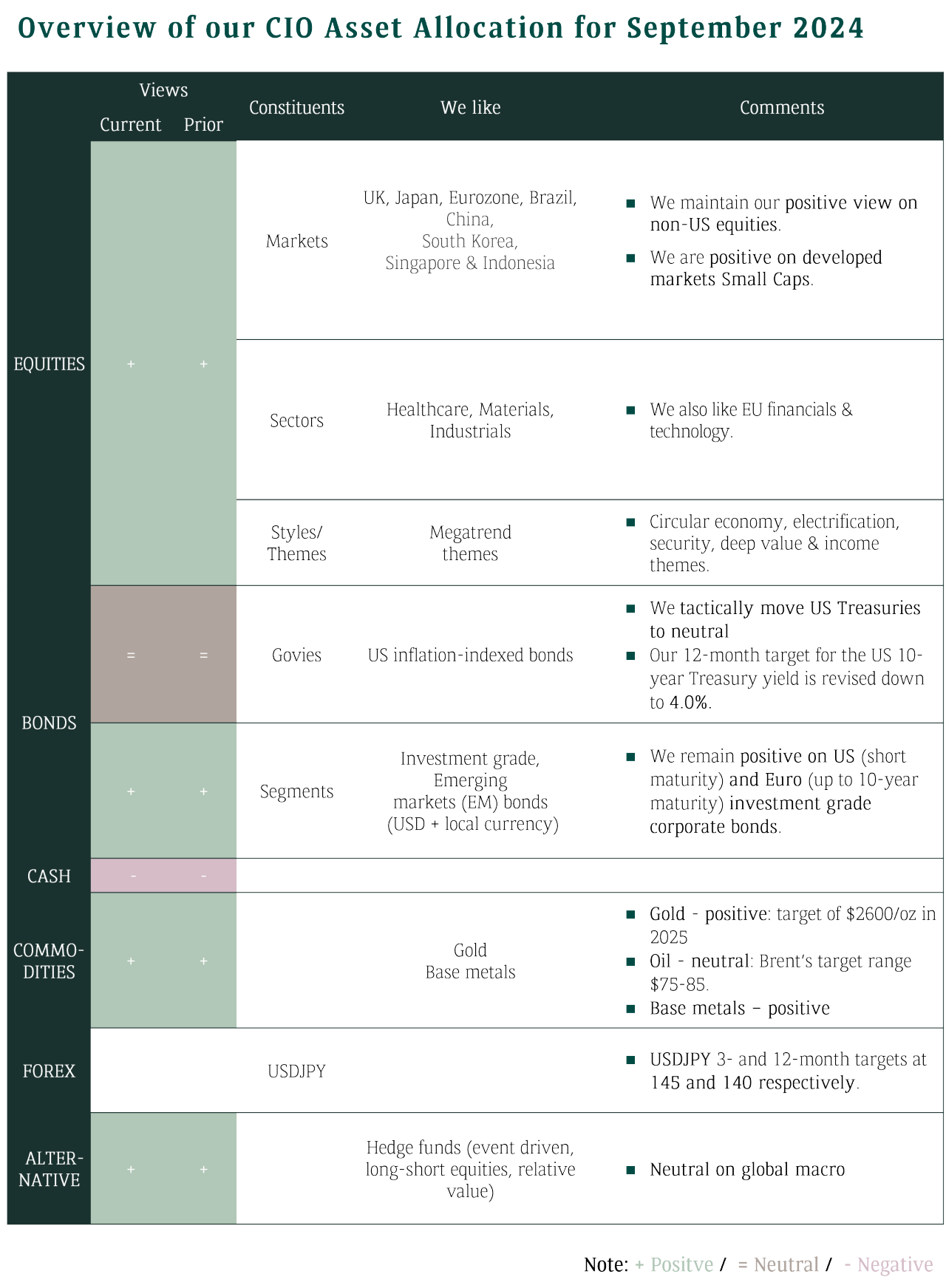Global markets suffered from a “double whammy” in early August
Global markets saw heavy sell-offs in early August 2024 due to (1) unwinding of carry trades following a hawkish Bank of Japan (BoJ) and (2) growing recession risk as the Sahm rule is triggered. Volatility was heightened to 65 on 5 August 2024, a level only recently seen during Covid. After the “Black Monday”, equity markets rebounded and volatility has normalised as yen stabilised after the BoJ said they will not hike rate when markets are unstable.
We believe around 70% of carry trades have been unwound and hence, the worst of positioning unwinding is likely behind us.

What is Sahm rule?
It is a recession indicator which states that when the 3-month moving average of the national unemployment rate is 0.5 ppt above its low over the prior 12 months, it signals the beginning of a recession.
US soft-landing remains our base case scenario
On the US, economic data in recent weeks indicates a soft-landing scenario, instead of any imminent recession. For example, ISM Services rose to above 50, the Senior Loan Offices Survey shows improvement in US credit demand, mortgage applications increased, US retail sales beat consensus and US consumer confidence reached a 6-month high.
Moreover, we have never seen a recession when US real wage growth remains positive. The Atlanta Fed GDPNow (a real GDP growth forecast for 3Q) is currently at 2.0%.
Sahm rule if applied to US initial jobless claims is not signalling a recession. Claudia Sahm, a former Fed economist who created the Sahm rule, also said the US is not in a recession.
Market expects aggressive cuts in the coming months. Is it overdone?
With inflation slowing and labour market softening, rate cut in September 2024 is almost a done deal. The question is whether it is a 25bp or 50bp cut.
The futures market is currently pricing in a 100bp Fed rate cuts by end-2024. The pace and depth of expected cuts is almost equivalent to a recession scenario. We believe this looks overdone.
We expect a 25bp cut in September and another 25bp cut in December this year if economic data continues to point to a soft-landing scenario.

Hence, we expect yields to rebound when we see more resilient US data in the coming months. Our 3-month target for US Treasury 10-year yield is 4.25% and 12-month target at 4%.
In the short-term, we tactically move our positive stance on US government bonds to neutral, although we remain constructive on the asset class strategically in the medium term. We intend to upgrade the asset class to positive again with better entry point if 10-year yields bounce back above 4%. We continue to be positive on short duration US investment grade bonds as yields remain attractive and credit spreads could tighten further as economic growth and investor demand persist.
Accumulate bonds when yields rebound
Bonds tend to perform well in a rate cut cycle, and they can also serve as a hedge to the recession risks. The bond rally in August 2024 is a remainder of how sensitive the bond market is over fears of a recession.
Furthermore, historical data shows that yields were down 3 months and 6 months after the first rate cut in both soft-landing and hard-landing scenarios.
Laggards are catching up
One interesting fact to note about the strong equity rally after the “Black Monday” is market breadth has been broadening. Magnificent 7 stocks saw a strong rebound but only recovered around half of their losses during the crash, while S&P ex-Magnificent 7 stocks reached fresh record highs in anticipation of a rate cut environment.

Apart from the US non-tech sectors, we also have been seeing rebound in laggards such as UK and Eurozone equities. We still believe there is plenty of room for the laggards to catch up. Investors should diversify their exposure to sectors such as healthcare and financials.
AI: Don’t miss the forest for the trees
Despite the recent losing momentum in the AI-related stocks, we do not think it is a “game over” for the AI investment theme. We believe we are still at the early stage of the AI revolution. Hence, corrections are buying opportunities.
Furthermore, Nvidia and semiconductor stocks are only the tip of the iceberg, and there are still plenty of opportunities in other areas such as software, data centre, hardware and cybersecurity. It is also widely believed that AI is likely to drive operating margin expansion for most of the industries, consumer services, financials, media and entertainment and healthcare to just name a few.
KEY RISKS
Strategies on equities, bonds, currencies & commodities
EQUITIES
We remain positive on global equities in the medium term, as a rate cut environment and improving liquidity should be supportive to the asset class if the soft-landing scenario remains intact. Lingering fear over recession, the upcoming US elections and seasonality headwinds may see rising market volatility in the autumn period. Nevertheless, any short-term weaknesses would be buying opportunities.
BONDS
We continue to like investment grade bonds. Any rebound in yields are good opportunities to accumulate bond exposure to lock in the attractive yields ahead of the Fed rate cut cycle. Bonds also act as a hedge to any hard-landing fears.
CURRENCIES & COMMODITIES
We expect the USD to consolidate in the near term after the recent sharp move, which provides good entry points for non-USD currencies, as we still see USD weakness in the medium term. We continue to favour gold and copper. Investors should buy on dips.
MONETISE VOLATILITY
Investors can take advantage of rising volatility to get asset class exposure via structured solutions that potentially capture the upside while managing the downside risk.
